Scientists described a strategy for controllable assembly of flexible bio-nanotubes
Date:09-08-2018 | 【Print】 【close】
Viruses with filamentous morphologies, such as tobacco mosaic virus (TMV) and M13 bacteriophage, have long been studied as multivalent nanoscaffolds for loading functional motifs. Structural assembly of the capsid proteins (CPs) of filamentous viruses often requires the presence of DNA or RNA molecules, which has limited their applications.
In a recent report, the research group led by Prof. CAO Sheng in Wuhan Institute of Virology of the Chinese Academy of Sciences described a strategy for controllable assembly of flexible bio-nanotubes consisting of Escherichia coli expressed CP of baculovirus Helicoverpa armigera nucleopolyhedrovirus (HearNPV) in vitro.
These protein-only nanotubes were studied as a new structural platform for high-density presentation of multiple active molecules on the exterior surface by direct fusion of the protein of interest to the N-terminus of HearNPV CP (HaCP). Structural characterization using cryoelectron microscopy demonstrated that the HaCP could assemble into two closely related but structurally distinct tube types, suggesting the tunable HaCP interaction network is the major contributor to the flexibility of HaCP nanotubes.
Their flexible nanotubes could tolerate larger molecular modifications compared with TMV-based templates and could be used as promising candidates for versatile molecular loading applications.
The results have been published in ACS Applied Materials & Interfaces entitled "Controllable Assembly of Flexible Protein Nanotubes for Loading Multifunctional Modules".
This work was supported by the National Natural Science Foundation of China and Chinese Academy of Sciences.


Contact:
CAO Sheng
E-mail: caosheng@wh.iov.cn
Wuhan Institute of Virology, Chinese Academy of Sciences, Wuhan 430071, China (http://english.whiov.cas.cn/)